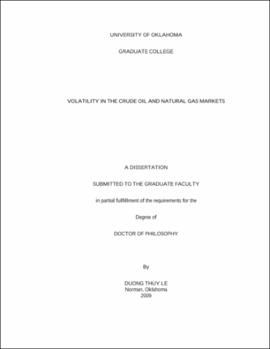| dc.contributor.advisor | EDERINGTON, LOUIS H | |
| dc.creator | LE, DUONG THUY | |
| dc.date.accessioned | 2019-04-27T21:41:30Z | |
| dc.date.available | 2019-04-27T21:41:30Z | |
| dc.date.issued | 2009 | |
| dc.identifier | 9996524502042 | |
| dc.identifier.uri | https://hdl.handle.net/11244/319355 | |
| dc.description.abstract | This dissertation consists of three essays which explore the determinants and properties of actual and implied volatilities in the crude oil and natural gas markets. The first two essays examine the causes and behavior of price volatility in the US crude oil and natural gas markets. I theorize and find that (1) the crude oil and natural gas markets are characterized by volatility persistence, (2) in the crude oil market, a negative shock has more impact on future volatility than an equal positive shock whereas in the natural gas market, predicted volatility increases more following a positive shock than an equal negative shock (3) crude oil volatility is lower at higher prices, (4) there is a day-of-the-week pattern in both markets, (5) OPEC meeting announcements and the Petroleum Status Report releases cause increased volatility in the crude oil market, (6) surprises in the change in natural gas in storage cause increased volatility in the natural gas market, (7) natural gas volatility tends to be higher during and immediately after bid week, (8) there is a month-of-the-year pattern in natural gas volatility, (9) natural gas volatility tends to be higher on winter days when the temperature is lower than normal, and (10) the conditional covariance and correlation between crude oil prices and the value of the dollar vary over time. In these two essays, I develop and employ an improved procedure for testing and quantifying the hypothesized volatility determinants within a GARCH type model. | |
| dc.description.abstract | The third essay examines the structure, characteristics, and determinants of implied volatilities (IVs) calculated from crude oil and natural gas options from September 1999 to June 2006. In several ways, the behavior of IVs in these markets is opposite to that observed in most financial options markets. Crude oil and natural gas IVs tend to increase as the options approach expiration. There is a positive "skew" pattern in natural gas IVs and long-term crude oil IVs in which IVs tend to be lowest at low strike prices and increase monotonically with strike prices. There is a time-of-the-year pattern in that natural gas IVs tend to be higher for options expiring in winter and crude oil IVs tend to be lower for options expiring in summer. Oil and gas IVs tend to decrease from Friday close to Monday close. After May 2002, natural gas IVs tend to decrease following the release of the Natural Gas Storage Report. A negative futures return has more impact on crude oil IV than an equal positive return while a positive futures return has more impact on natural gas IV than an equal negative return. IV is a fairly efficient forecast of future volatility in these markets but its forecasting power differs across terms-to-maturity and strike prices. | |
| dc.format.extent | 192 pages | |
| dc.format.medium | application.pdf | |
| dc.language | en_US | |
| dc.relation.requires | Adobe Acrobat Reader | |
| dc.subject | Petroleum products--Prices | |
| dc.subject | Gas industry--Prices | |
| dc.subject | Commodity options | |
| dc.title | VOLATILITY IN THE CRUDE OIL AND NATURAL GAS MARKETS | |
| dc.type | text | |
| dc.type | document | |
| dc.thesis.degree | Ph.D. | |
| ou.group | Michael F. Price College of Business | |
